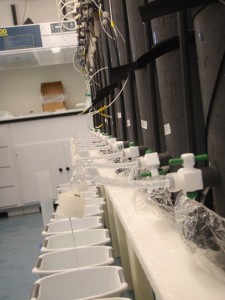Iron is essential for life on Earth. We need iron as an essential nutrient, and so do the tiny microscopic plants, or phytoplankton, that grow in the surface of the ocean. When oceanographers first started to study iron in the ocean thirty years ago, we thought there was a lot more iron in the ocean than there actually is. This was because we were accidentally measuring the wrong amount of iron in our samples, because we were sampling from ships made of iron and contaminating our samples with extra iron. Since then, we have developed specialized techniques for taking iron samples from ships, and we realized that iron is present in very low concentrations. Even though iron is necessary for life, it is scarce in the ocean because it has a complicated chemistry. As a result, some phytoplankton in certain areas of the ocean, are not able to get all of the iron they need to grow. This has made the competition for iron in the ocean a fierce one; and phytoplankton and bacteria have developed strategies in order to get the iron they need. One of these strategies involves producing certain organic compounds, called siderophores (“iron-loving” compounds), which change the chemistry of the iron and can make it easier for them to take up that iron. As a trace metal chemist, I study the distributions of iron in the ocean and it’s chemical forms. By figuring out the chemical forms of iron in seawater, I am able to begin to figure out which types of phytoplankton and bacteria are making siderophores, or the compounds that help them access iron. And for this iron woman, that is a very interesting question to answer.


